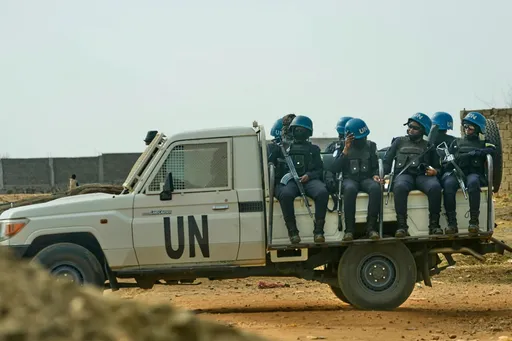Morocco continues to reel from the devastating impact of a magnitude 6.8 earthquake that struck on September 8, causing the deaths of more than 2,800 people.
The epicentre was the Ighil area, a mountainous rural commune home to small farming villages in Al-Haouz province.
It struck at 11:11 p.m. local time when most locals were asleep, catching them completely unaware.
Although rare, powerful earthquakes have occurred in Morocco before including a 5.9-magnitude that struck coastal Morocco near Agadir in 1960, killing more than 15,000 people.
The latest disaster on September 8 has added to the list of earthquakes the have shaken the world in the past two decades.
Here is a look at previous ten deadliest earthquakes around the world in past two decades:
Türkiye, February 2023
Türkiye experienced a devastating day on February 6, 2023, when two earthquakes occurred nine hours apart, severely impacting 11 provinces.
The epicentre of these earthquakes measured 7.7 and 7.6 on the Richter scale and was located in Kahramanmaraş’s Pazarcık and Elbistan districts, causing some regions to move seven metres from their original positions.
The earthquake, which occurred at a depth of 7 kilometres, lasted for over 30 seconds and also severely impacted the cities of Aleppo, Latakia, Hama, and Idlib in Syria. Subsequently, there were 6,414 aftershocks in the following two weeks.
The total number of casualties in Türkiye was more than 50,000 and in Syria was about 5,000.
Nepal, April 2015
Unlike the earthquakes in Morocco and Türkiye which occurred at night, Nepal’s quake struck just before noon on April 25, 2015, and sent a wave of destruction from its epicentre northwest of Kathmandu.
The earthquake, which claimed about 9,000 lives, stands as one of the worst natural disasters in Nepal’s history.
The powerful quake sent tremors that were felt in India, Tibet, and even on the peaks of Mount Everest.
In addition to those it killed, the 7.8-magnitude earthquake destroyed 600,000 structures in Kathmandu, injured more than 22,000. It reached Mount Everest, triggering an avalanche that killed at least 19 mountaineers.
Japan, March 2011
On March 11, 2011, more than 15,500 people died after being struck by waves of a tsunami following an earthquake that struck in the Pacific Ocean, 130 kilometres (81 miles) east of Sendai, the largest city in the Tohoku region of Japan.
The Tohoku tsunami produced waves up to 40 metres (132 feet) high. In addition to the thousands of destroyed homes, businesses, roads, and railways, the tsunami caused the meltdown of three nuclear reactors at the Fukushima Daiichi Nuclear Power Plant.
The Fukushima nuclear disaster released toxic, radioactive materialsinto the environment and forced thousands of people to evacuate their homes and businesses.
Haiti, January 2010
This earthquake struck on the West Indian island of Hispaniola, comprising the countries of Haiti and the Dominican Republic, on January 12, 2010.
Most severely affected was Haiti, with the Haitian government’s official count recording an astronomical 300,000 casualties, which would make the earthquake’s aftermath one of the worst natural disasters in recorded history.
The earthquake hit at 4:53 PM, some 15 miles (25 km) southwest of the Haitian capital of Port-au-Prince.
The initial shock registered a magnitude of 7.0 and was soon followed by two aftershocks of magnitudes 5.9 and 5.5. More aftershocks occurred in the following days, including another one of magnitude 5.9 that struck on January 20 at Petit Goâve.
China, May 2008
The devastating earthquake occurred in the mountainous central region of Sichuan Province in southwestern China on May 12, 2008.
The epicentre of the magnitude 7.9 quake was located near the city of Dujiangyan, about 50 miles (80 km) west-northwest of Chengdu, the provincial capital, at a depth of 11.8 miles (19 km) below the surface.
Whole villages and towns in the mountains were destroyed, and many schools collapsed, resulting in the deaths of more than 5,300 children, the bulk of whom were students attending classes.
Almost 90,000 people were counted as dead or missing and presumed dead in the final official Chinese government assessment.
Indonesia, May 2006
A powerful earthquake rattled Yogyakarta, Java, Indonesia, in the early morning hours of May 27, 2006, and killed an estimated 6,234 people and destroyed more than 60,000 houses in the city.
The sultanate province of Yogyakarta Special Region was closest to the epicentre, and Bantul regency was the worst affected region.
More than 350,000 families lost their homes in central Java, and 1.5 million people were affected.
Pakistan, October 2005
Pakistan’s earthquake of 2005 (also called the Kashmir earthquake) killed at least 79,000 people and destroyed more than 32,000 buildings.
It measured a magnitude of 7.6 and destroyed the Muzaffarabad area, collapsing at least 32,335 buildings in various cities in the Kashmir region—including Anantnag and Srinagar in Jammu and Kashmir state.
The number of injured is estimated at more than 69,000. At least 1,350 people were killed and 6,266 injured in Jammu and Kashmir state in India, and the tremors were felt at a distance of up to 620 miles (1,000 km), as far away as Delhi and Punjab in northern India.
Four fatalities and 14 injured survivors were reported in Afghanistan. The property loss caused by the quake left an estimated four million residents homeless.
Indonesia, December 2004
Just like Japan’s earthquake, the quake that struck the west coast of Sumatra, Indonesia, on Sunday morning, December 26, 2004 also triggered a powerful tsunami.
The quake measured 9.1 on the Richter scale, with the epicentre approximately 250 kilometres south to south-west of Banda Aceh, Indonesia.
The towering waves travelled at 80 km/h in shallow water and struck the coasts of northern Sumatra and the Nicobar islands. Waves of up to 30 metres were recorded as the tsunami swept through Aceh, the hardest-hit region of Indonesia.
Around two hours after the earthquake struck, waves reached Sri Lanka, India, and Thailand. An hour later, they reached the Maldives, and more than seven hours after the initial quake, the tsunami was observed in Mauritius and along the east coast of Africa.
The earthquake and subsequent tsunami caused the deaths of approximately 227,000 people in fourteen countries, according to the United Nations.
Iran, December 2003
On Friday, December 26, 2003, at 5:26 a.m., Bam city in south-eastern Iran was jolted by an earthquake registering 6.5 magnitude on the Richter scale.
Official death tolls exceeded 30,000 fatalities, 9000 injured, and 525 declared missing.
A United Nations report at the time estimated that about 90% of the city’s buildings were 60%–100% damaged.
India, January 2001
The earthquake struck near the town of Bhuj on the morning of India’s annual Republic Day, Jan. 26 (celebrating the creation of the Republic of India in 1950), and it was felt throughout much of northwestern India and parts of Pakistan.
The magnitude of the quake was 7.7 (6.9 on the Richter scale) and it killed more than 20,000 people and injured more than 150,000 others.
The quake left hundreds of thousands homeless and damaged more than a million buildings.
























